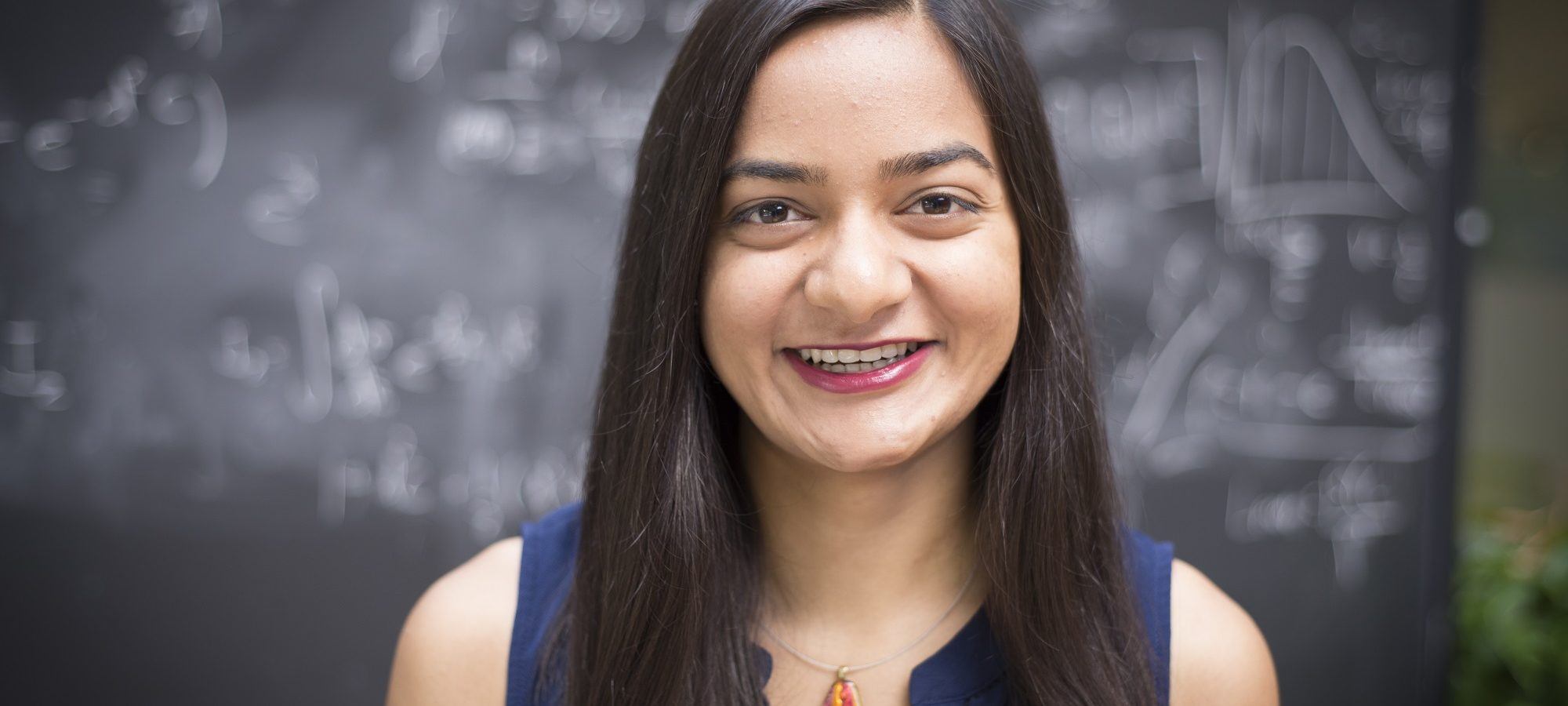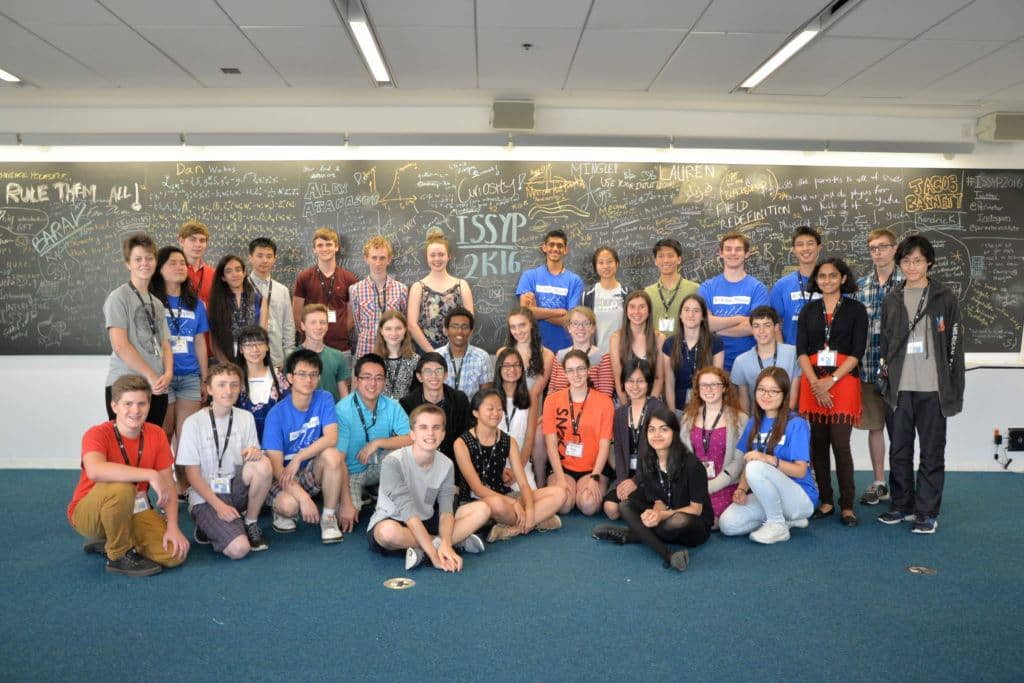People of PI: Teen science whiz Maya Burhanpurkar
Most people who take a year off between high school and university pack a swimsuit and head to the airport. Former ISSYP student Maya Burhanpurkar came to work at Perimeter Institute.
Take a self-guided tour from quantum to cosmos!
Most people who take a year off between high school and university pack a swimsuit and head to the airport. Former ISSYP student Maya Burhanpurkar came to work at Perimeter Institute.

You could call it the curse of curiosity. If you’re as excited by physics as you are about engineering, computer science, philosophy, and art, how do you choose what to pursue?
This is the quandary that brought Maya Burhanpurkar to Perimeter Institute in January, 2017, to spend seven months working as a research associate. That followed a previous gap-year project at the University of Toronto, where the teen helped design an algorithm to enable power wheelchairs to detect and drive themselves through doorways.
“I was hoping that I would really hate one of the two experiences, so that I would default into the other one,” admits Burhanpurkar, who is from Oro-Medonte, in rural Ontario. “Unfortunately, I love both of them even more now.”
For a budding polymath who has prototyped an “intelligent” antibiotic, uncovered a new principle of Newtonian physics, worked on an asteroid-tracking project, and made an award-winning documentary about climate change, working out what to focus on can be as big a challenge as the projects she takes on.
She’s delighted to be helping develop software to detect fast radio bursts with the CHIME telescope, working for Perimeter Faculty member and cosmologist Kendrick Smith, whom she first met while attending the International Summer School for Young Physicists (ISSYP) in 2016.
“What surprised me about cosmology is indeed just how much of physics you need to know in order to do it,” she says. This project, in particular, appeals to her eclectic approach to life. “CHIME is actually a hardware engineering project, a software engineering project, and a physics project, all in one. It’s perfect!”
It could be easy to pass Burhanpurkar off as yet another precocious, outgoing teen, but it doesn’t all come naturally. She loves public speaking and science outreach, but also considers herself a shy person. “I find it very difficult to ask people to do things for me, or to ask favours of people,” says Burhanpurkar, who turned 18 while working at Perimeter. “When I get really excited about something, it makes me a lot more inclined to ask for help, because I just really want to see that project come to fruition, and I know that I don’t have the skills to do that on my own.”
That is one of the key messages she wants other young people – girls in particular – to hear, and a driving force behind her participation in the Inspiring Future Women in Science Day at Perimeter in March. She wants other girls to know that science isn’t a solo pursuit. You don’t have to know everything, or to do it on your own, and it’s okay if things don’t work out the first, second, or fifth time.
“I started doing science in a basement laboratory in which my incubator was a pop can cooler with an electric heating blanket stuck inside of it. That’s pretty much as poor a scientific environment as you can have,” she says.
“It was this iterative process of making a ton of mistakes, and then eventually after years, I got somewhere. I think it’s important to highlight the failures as well as the successes, so that people know that it’s not just success after success after success.”

She has also stepped up as a role model for curious girls – in large part because she continues to seek out role models herself.
Ask most people to name great scientists, and they’ll probably cite men like Einstein, Darwin, Maxwell, or Stephen Hawking. Yet women have made countless contributions to science, and Burhanpurkar is making it her mission to help shine a light on that, appearing on CBC Newsworld and TVO’s The Agenda, appearing in the We Are Canada documentary series for the country’s 150th anniversary, and travelling across Canada to speak to students who aren’t that much younger than herself.
“There are so many females in science today who are doing amazing work. I just think it’s really important that we get those narratives out there so that young people will hear about them,” she says. “Having women tell their stories of how they got started in science and what makes them passionate can do an awful lot to inspire young people.”
Burhanpurkar still has time to work out what path she’ll follow to make her own mark on the world – she starts at Harvard University in August, and doesn’t have to choose a major until second year. In the meantime she’s soaking up as much as she can at Perimeter, and eagerly anticipating her next chapter.
“I know so little about the world, and college is a fantastic opportunity. Four whole years just to spend learning. I’m really excited about that!”
A round-up of the latest news from Perimeter, a look at the recent work of researchers and alumni, gems from the archive, and fun physics for everyone
38 participants from 16 countries joined in this year’s International Summer School for Young Physicists, grappling with the complexity of modern physics and building connections that last.
The CHIME/FRB Collaboration reveals a new type of fast radio burst with pulses spaced milliseconds apart in a new paper released today in Nature.